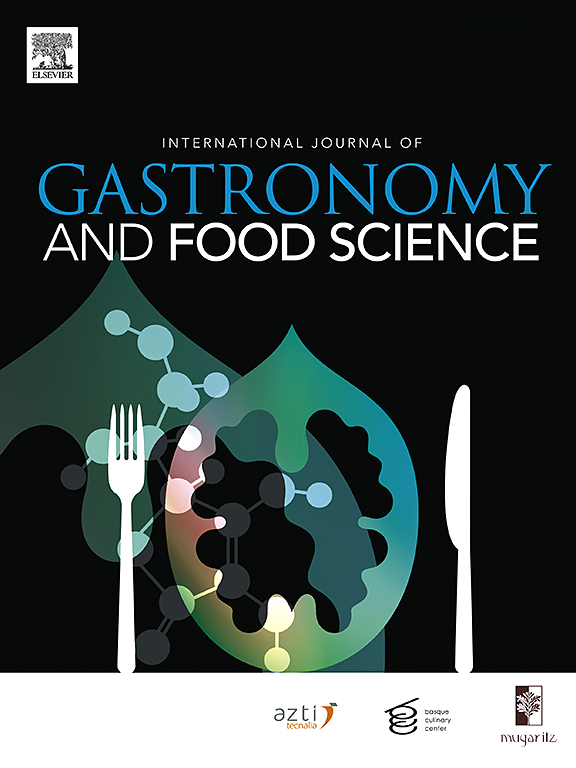3D-printability of culinary foams prepared with aquafaba powder
IF 3.2
2区 农林科学
Q2 FOOD SCIENCE & TECHNOLOGY
International Journal of Gastronomy and Food Science
Pub Date : 2025-04-05
DOI:10.1016/j.ijgfs.2025.101175
引用次数: 0
Abstract
This study investigated the potential of foaming non-natively extrudable foods, specifically apple puree and caramel sauces, for 3D food printing (3DFP) applications. Aquafaba, recovered from chickpea cooking, was used as a foaming agent due to its high foaming properties and plant-based nature. Caramel samples exhibited Newtonian behavior, while apple samples followed the Power Law model, transitioning to Bingham-Plastic fluid behavior at higher aquafaba concentrations. Foaming properties increased with aquafaba concentration, with enhanced foam stability and reduced liquid leakage. Monomodal bubble size distributions were observed, with smaller bubbles in caramel foam due to higher viscosity. Sensory analysis revealed changes in appearance, consistency, and mouthfeel with increasing aquafaba concentration. Infill ratio and foam aging significantly influenced the length and height of printed pyramid shapes, with apple foam displaying greater size discrepancies. Foam aging and printing effects increased Sauter mean diameter and overrun values. Despite distortions in high infill ratio prints, smoother surfaces were achieved with longer foam aging. Finally, octopus shapes exhibited closer adherence to the 3D model dimensions, with decreasing height trends over time. This study highlights the potential of aquafaba-based foams for 3DFP applications, offering new opportunities for innovative and customizable food designs in gastronomy. These applications are especially valuable for enhanced sensory experiences while maintaining a focus on sustainability and plant-based ingredients.

用aquafaba粉制备的烹饪泡沫的3d可打印性
本研究调查了发泡非天然可挤出食品的潜力,特别是苹果泥和焦糖酱,用于3D食品打印(3DFP)应用。从鹰嘴豆烹饪中回收的Aquafaba因其高发泡性和植物性而被用作发泡剂。焦糖样品表现出牛顿行为,而苹果样品则遵循幂律模型,在较高的水aba浓度下过渡到宾厄姆-塑性流体行为。泡沫性能随水龙巴浓度的增加而增加,泡沫稳定性增强,液体泄漏减少。观察到单峰气泡尺寸分布,焦糖泡沫中由于粘度较高,气泡较小。感官分析显示,随着水aba浓度的增加,外观、稠度和口感发生了变化。填充率和泡沫老化显著影响印刷金字塔形状的长度和高度,其中苹果泡沫尺寸差异较大。泡沫老化和印刷效应增加了索特平均直径和溢出值。尽管在高填充比的印刷品中会出现扭曲,但泡沫老化时间越长,表面越光滑。最后,章鱼的形状表现出更接近3D模型的尺寸,随着时间的推移,高度呈下降趋势。这项研究强调了基于aquafaba的泡沫在3DFP应用中的潜力,为美食领域的创新和可定制食品设计提供了新的机会。这些应用对于增强感官体验尤其有价值,同时保持对可持续性和植物性成分的关注。
本文章由计算机程序翻译,如有差异,请以英文原文为准。
求助全文
约1分钟内获得全文
求助全文
来源期刊

International Journal of Gastronomy and Food Science
Social Sciences-Cultural Studies
CiteScore
5.30
自引率
10.50%
发文量
170
审稿时长
45 days
期刊介绍:
International Journal of Gastronomy and Food Science is a peer-reviewed journal that explicitly focuses on the interface of food science and gastronomy. Articles focusing only on food science will not be considered. This journal equally encourages both scientists and chefs to publish original scientific papers, review articles and original culinary works. We seek articles with clear evidence of this interaction. From a scientific perspective, this publication aims to become the home for research from the whole community of food science and gastronomy.
IJGFS explores all aspects related to the growing field of the interaction of gastronomy and food science, in areas such as food chemistry, food technology and culinary techniques, food microbiology, genetics, sensory science, neuroscience, psychology, culinary concepts, culinary trends, and gastronomic experience (all the elements that contribute to the appreciation and enjoyment of the meal. Also relevant is research on science-based educational programs in gastronomy, anthropology, gastronomic history and food sociology. All these areas of knowledge are crucial to gastronomy, as they contribute to a better understanding of this broad term and its practical implications for science and society.
 求助内容:
求助内容: 应助结果提醒方式:
应助结果提醒方式:


